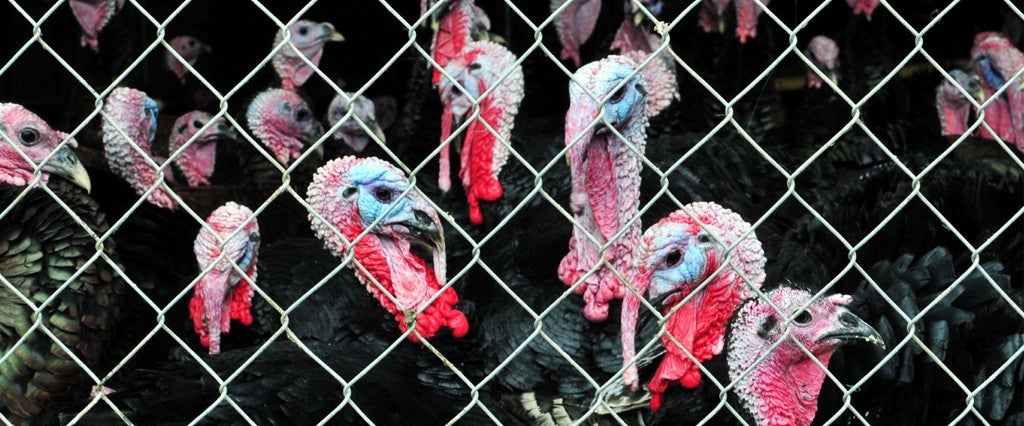Sixty-nine-year-old Frank Reese Jr. stands with his hands on his hips and looks out over his barnyard. Today, roughly three weeks before Thanksgiving, a semi-truck will take most of his flock — the finest poultry in North America — from his small hilltop farm among the rolling prairie of central Kansas to a processing facility in Ohio. There, many of the birds he’s shepherded daily since their hatching will be butchered for dinner tables throughout the country.
The semi is a tight fit in his yard, which was built before big trucks became commonplace. He hired a pack of teenagers to help load turkeys, one by one, onto the truck. But at the moment, they’re merely watching the driver struggle with the tight space. Eventually, one of the kids runs up to the cab and offers suggestions.
“We’ll get it figured out eventually,” Frank says, turning his back against the cold wind out of the north. He tells the high schoolers that they’ll be loading somewhere between 2,000 and 3,000 turkeys in all. “Your arms will probably get tired,” he warns.
To start, though, they have to move more than 1,000 turkeys from one barn to another across the yard where Frank can inspect each individually. (Frank has many barns and outbuildings around the property — the big ones are steel, elongated rectangles, maybe 80–100 feet in length, ground-story only and ventilated for the health of the birds.) Frank opens the big barn door, and two of the kids herd the flock with plastic yard rakes into the sunlight. The birds are cautious, but once they’ve figured out where they’re going, the flock moves with military precision.
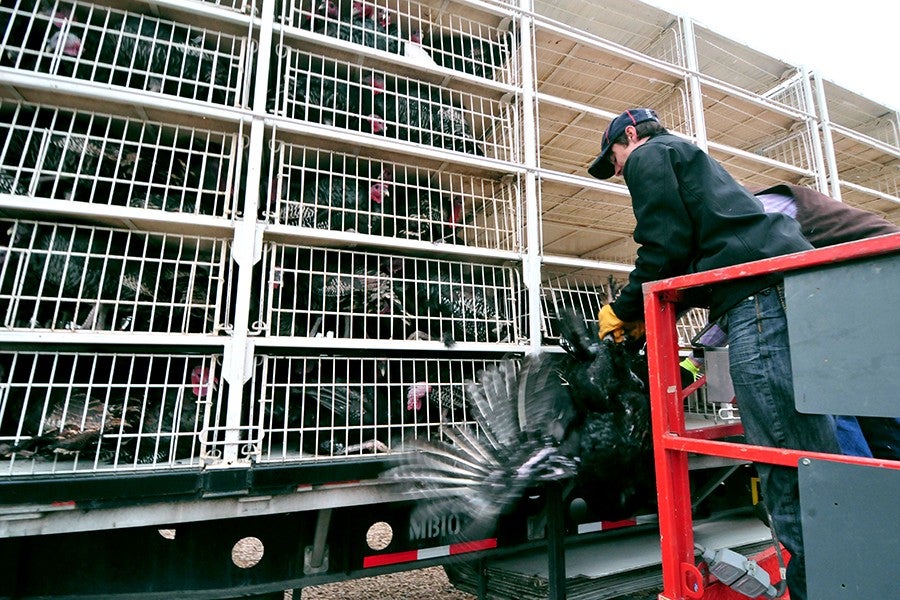
Frank goes over the loading plans with his neighbors, Jim and Tammy Dahlsten, as the truck driver jack-knifes his trailer and decides to try another maneuver. The Dahlstens are wheat farmers, typically. But they’re trying turkeys this year because of the low price they get for wheat. They figured, Why not something that’s a little less common? In particular: Rare, standardbred, specialty market turkeys.
Frank is wearing a flannel jacket and a Carhartt winter cap. The hat looks clean enough to be new, but the jacket has been through this before. Freshly caked turkey shit covers the front. It looks like a frozen cascade of mustard and mayonnaise. Frank doesn’t seem to mind. He’s a farmer. Farmers can handle it. There’s a bounce in his step, too—maybe thanks to the Crocs he usually wears, when it isn’t quite as cold.
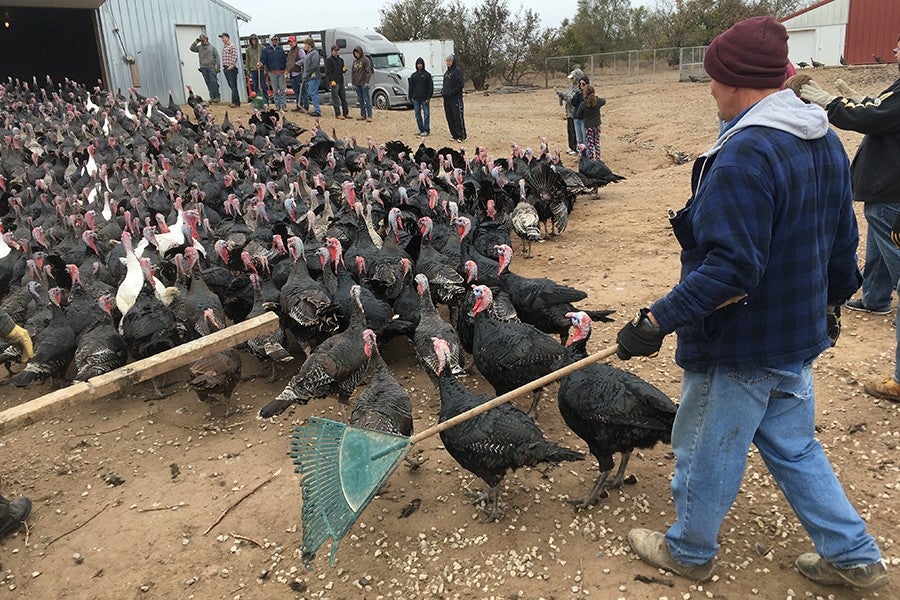
One of his nephews has pulled a youngish tom turkey out of the line, and instead of putting it on the butcher truck, he crosses the yard, headed for Frank. He’s holding the tom upside down by the feet. The bird’s wings are spread and gently flapping. Frank takes the bird and turns it upright, cradling it like a large football. He looks at the bird’s shape, the width of its back and the barring pattern on its feathers before measuring it with his free hand, gently pulling apart some of the feathers for a closer look. Behind us, turkeys are yelping and clucking, flapping up clouds of dirt and dust. I wince instinctively to keep the dirt and flying turkey shit out of my eyes.
“He’s impressed,” says Ryon Carey, Frank’s business partner and fellow turkey rancher. “It’s definitely smaller than what Frank likes to see in a butcher-ready bird, but there’s something else he likes about it.”
This is what selective breeding looks like: The breeder chooses the birds they like, and those birds don’t go to the slaughter house (at least not yet). Instead, they become parents of similarly magnificent fowl — and so on and so on and so on…
Frank lifts the chosen bird away from his body for one last look. Then he pivots toward the barn and carefully launches it underhand into a low, direct, somewhat awkward flight to safety. The little tom lands running, kicking up loose dirt.
“He gets to live!” Frank announces to the rest of us.
* * * * *
Frank’s pursuit of the perfect turkey started very early, with chores before school. In young Frank’s case, this meant feeding the birds. He loved them immediately. Soon, he adopted a mentor, Norman “Turkey Man” Kardosh, and learned about the art of bird breeding. Years later when Norman was dying, he asked Frank to continue his life’s work and save the birds. This is part of the reason Frank says he can “see people” when he looks at his turkeys.
As the torch-bearer for traditional animal husbandry in the 21st century, his status has been elevated to something well beyond turkey farmer. “Frank Reese [is] a kind of priest of chicken, who lives in the middle of the Kansas prairies and is preserving the old lines of chicken that the industry rejected,” Maryn McKenna, author of Big Chicken: The Incredible Story of How Antibiotics Created Modern Agriculture and Changed the Way the World Eats, told the Atlanta Journal-Constitution last month. “Not just because he loves them, but because he believes that the industry will need their genetics once again.”
Frank’s fans include Martha Stewart (he’s been a guest at both her home and on her show); celebrity chef Bobby Flay (who learned of Frank’s work on an episode of Iron Chef America where the challenge was to make dishes based on his standardbred turkeys); and actress and activist Natalie Portman (who produced the documentary Eating Animals based on the nonfiction book about the ethics of industrial livestock with the same title by Jonathan Safran Foer, in concert with the nonprofit Farm Forward).
Despite this adulation, he spends his days as predictably as he can. With a set daily rhythm, his birds understand the calm order of the day. “They know that when I grab that rake in the evening, it’s time to go into the barn. Or when I start the motor on the feeders, they’re ready for it. They’re just like people, honestly. You get sick when you’re stressed. They’re the same way.”
Incidentally, he does know a thing or two about human health as well. Since 1973, he’s held a significant number of lives in his hands as a certified registered nurse anesthetist specialist—the person who provides anesthesia to patients for treatments and surgeries. He says he doesn’t spend as much time at the hospital as he used to, but he still goes on call several times a week. Without his income as an anesthesiologist, his poultry farm might not have made it.
“The industry has done a terrific job of pushing out the small farmer,” he says. “The way in which we eat in America — I’m talking about the types of birds we eat — has only been in existence for 40 years. If you go back before that, everybody ate the types of birds I raise. It’s crazy that we now produce these deformed, sickly animals to ‘feed the world’ [instead]. But the truth is those birds aren’t feeding the world. They’re feeding the fast-food industry. They’re broiler chickens that go into fast food. Seventy percent of all the broiler meat being produced today goes into value-added products and fast food. When the industry talks about staying sustainable, they mean keeping the level of production for fast food. The idea of sustainability has nothing to do with these nice flowery ideas of being good for the earth and environment — they’re trying to figure out how to appease the public.”
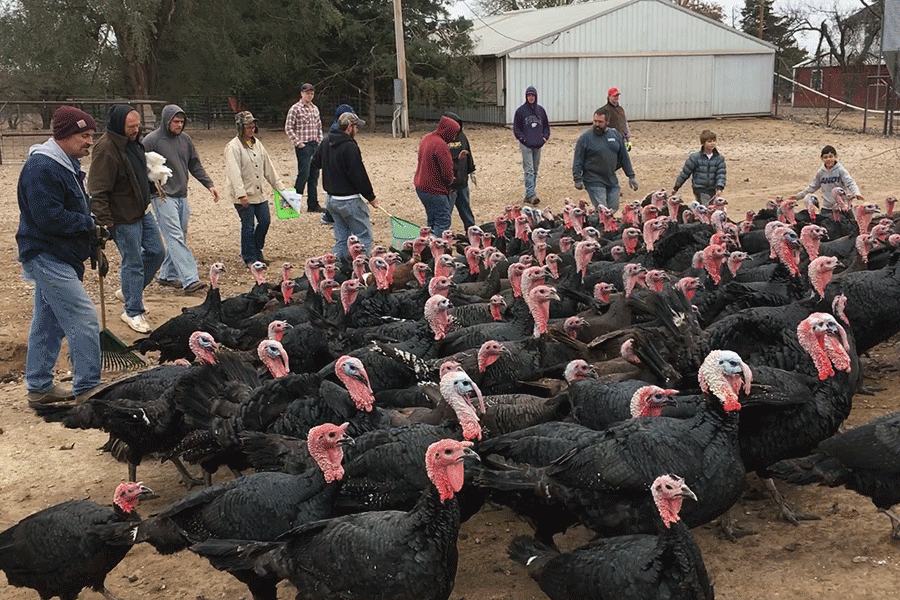
Luckily for Frank, the farm-to-table movement has found great value in him and his birds. “Back when I first met Frank, I was just going to check out these turkeys. But I soon realized his farm was like a living museum for these breeds and lines, which he had saved from different people’s farms and had been keeping going for 50 years,” says Patrick Martins, the founder of Slow Food USA and co-founder of Heritage Foods USA. “I was like, ‘Wow, how do we help?’ Frank said, ‘The only way to save these birds is to eat them.’ Slow Food didn’t really talk about that. We only wrote a nice article and took some lovely pictures. Frank was like, ‘Well, I need to sell these birds.’”
Today, Heritage Foods buys Frank’s entire flock and distributes it nationwide. Without this market — and its connection to smaller-scale poultry processing facilities (which are few and far between nationwide) — it’s difficult to imagine Frank remaining in business. Still, his production is much bigger than a hobby farm. He’s even been expanding his operation beyond his own farm, bringing in neighbors and other farmers like the Dahlstens to raise more turkeys and chickens for Heritage Foods.
“If we’re just talking about turkeys,” explains Frank, “I have the Standard Bronze, which is the turkey that everyone knows about. From the Bronze, you can get all other turkeys. The white ones are White Hollands. Bourbon Reds are the big brown or chestnut and white ones. They take the longest to gain weight, and they can get a little bigger than the others. The silvery ones are Narragansetts. “Then for chickens, I’ve got Plymouth Barred Rocks, New Hampshires, Cornishes and Jersey Giants.” The list goes on: Rouen ducks borne from the wild mallard; Toulouse geese that originated in the South of France; and African geese, which came from wild swan.
But no matter the breadth of his menagerie, his constant existential threat — bachelorhood — always looms large. As he enters his 70th year, he is the last of his farming family. He never married and never had children. He says other relatives like his nephews are busy doing other things and not interested in taking over the farm. So he worries that the genetics on his farm will die with him. His best laid plan: To build The Good Shepherd Poultry Institute on his land, where work on this classic style of poultry breeding can continue. (He reckons $2.5 million would be a good start toward making that happen — money he currently doesn’t have.)
“It’s going to take a nonprofit like Farm Forward to take it over and make things work,” Frank says about the future of the farm and his legacy.
* * * * *
The day after we send off most of his turkeys for slaughter, Frank surveys his now much smaller flock. He’s keeping a close eye on them because they’re antsy, having been shuffled, handled and disrupted from their routine — not to mention that hundreds of their siblings and offspring are missing. “I don’t like to see them so anxious, but that’ll pass,” he tells me. “They’ll be back to normal in a few days.”
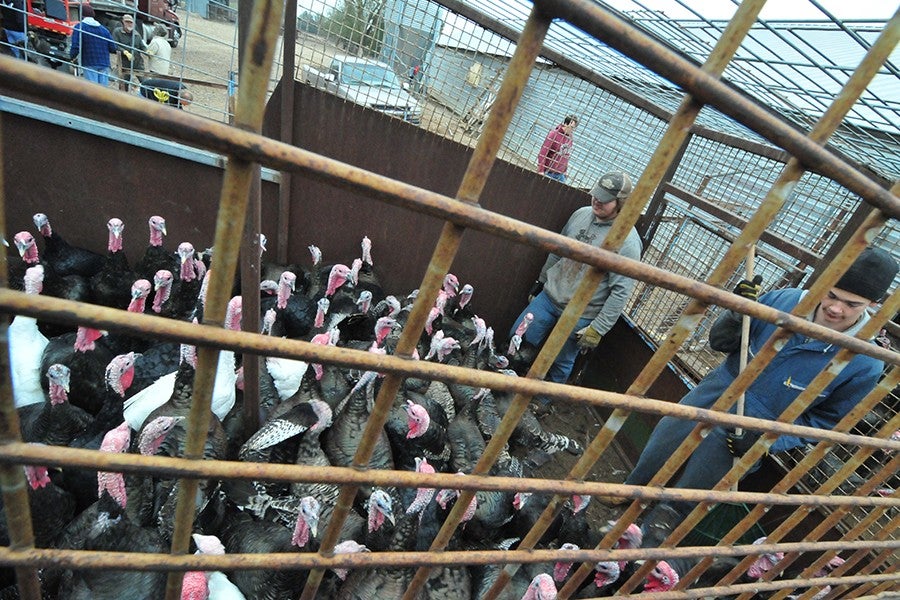
I follow him to an insulated part of a smaller barn where he pulls out a single rack of about 120 palm-size chicks that are chirping away. He selects a dead one and flings it into the yard. “The dogs will take care of that for me,” he remarks matter-of-factly. “My dad always said, ‘If you’ve got livestock, you’ve also got deadstock.’”
We meander back out into the sunshine where the turkeys are sunning. I ask Frank if he’s ever ordered a chicken sandwich at a fast-food restaurant. He laughs before I can finish the question. “Never. I actually eat very little meat. And if I do, it’s only my chickens or turkeys. I haven’t eaten factory meat, beef or pork for years and years and years. I don’t want to support that type of farming — something that I think is bad for farmers and people. It’s beyond me that any parent would risk it to feed their kids the stuff from the store.
“I had some industrial birds here and I treated them like my birds — fed them the same thing I would mine. What was so sad is that those poor turkeys wanted to run, wanted to jump, wanted to move, and they just sat. The brain wanted to be normal, but they were physiologically incapable of doing those normal things. If we expect better health out of ourselves, shouldn’t we expect better from our meat?”
Modern industrial turkey breeders have bred a hybrid big-breasted white turkey that’s so large it can’t reproduce on its own, which is where artificial insemination has been useful. Plus, AI allows commercial breeders to better control the sexes of the birds so they can raise fewer toms, since toms have a lower rate of hatchability. No matter the sex, once hatched, the turkeys’ beaks and toes are trimmed before they’re vaccinated and sent to a grow-out farm to put on considerable amounts of weight. “Theirs is the ratio of growth-to-feed,” Frank explains. “‘How much muscle mass can we get for the least amount of feed?’ All of the bird’s problems — like bad legs, congestive heart failure and liver disease — can be treated with antibiotics or vaccines. But I was taught to raise a balanced bird. If one characteristic like reproduction is picked over any other thing, you’re out of balance.”
“And so, the industry is out of balance,” Frank continues. “Did you know that every chicken you buy in the store is one genetic animal? There’s absolutely no difference between each bird. You can call it whatever you want: Organic or free range, but it’s the same genetic thing. And guess what Mother Nature doesn’t like: Monoculture. Look at the potato famine. It’s not a matter of if, but when it’s going to come back and bite us.”

One of Frank’s hens bites at the shiny zipper on my jacket. Frank points at it and says, “That little hen there carries the genetic gene pool to produce everything else. From within her, you can make White Hollands, Narragansetts, Bourbon Reds — she’s got everything in her. You could even breed her to look like a factory industrial turkey. But why would anyone do that? The industry thinks it can outsmart Mother Nature. But they’re wrong. Any time you think you’re playing God, Mother Nature will smack you down.”
An airplane flies low, about 1,000 feet overhead, and the turkeys are annoyed — rustling, flapping and making a shrill squawking gobble. The plane gets closer, and they form a tighter group and turn collectively toward the barn where they spent the night having just missed a ride on the meat truck. They aim their heads lower along the ground, tuck their wings and do a running waddle directly for the barn. Undercover, they’ll stick together until the airplane is out of sight.
“You see what they did there?” Frank asks me rhetorically. “They reacted like it was a hawk flying over to attack. It’s an instinct thing. If those were commercial birds, they’d still have the instinct to run for cover, but they couldn’t. Their legs are too short, and they’re basically obese. They wouldn’t stand a chance.
“Imagine if they were humans instead. It would be like we were raising a kid who was 500 pounds by age 9. That’s what [the industry] is doing. We go on and on about how we should all be healthy, and yet, the way we produce meat here is that it has to be morbidly obese. Then we wonder why we have to feed them millions of tons of antibiotics. Take 10,000 morbidly obese human beings and shove them in a building and see how long they last.”
* * * * *
Wedding guests file into the local bar, The Öl Stuga, in the nearby town of Lindsborg, about seven miles east of Frank’s farm. It’s not full every night, but the wedding has brought some new faces to join the regulars. The owner of The Stuga, as it’s also known, is celebrating 40 years in business, operating as the hangout where football fans go after watching the Bethany College (the local, Lutheran, liberal arts school) “Terrible Swedes” play against other small private universities. Any number of patrons here speak at least a little bit of Swedish and have probably worn traditional Swedish costume and tights to dance in the local festival Svensk Hyllningsfest, a biennial two-day gathering that celebrates Swedish folk heritage in Lindsborg.
This is a town that honors artistry in many forms. For example, I saw Wynton Marsalis play and talk about jazz at Bethany when I was a kid. Among the others who have passed through town: documentarian Ken Burns, Marsalis’s fellow jazz man Lionel Hampton and Prairie Home Companion creator Garrison Keillor. Its choir (the Bethany Oratorio Society) once sang at Carnegie Hall — they performed Handel’s The Messiah, which they’ve also performed at Bethany College annually since 1882. And Mikhail Gorbachev came to Lindsborg on the Chess for Peace mission, which led to the opening of the Anatoly Karpov International School of Chess across the street from The Stuga. (Gorbachev spent the previous evening drinking beer with locals there.)
Jim Turner, the president of the chess club and long-time local photographer, keeps a photo of Gorbachev laughing with the boys at The Stuga. He says Lindsborg seemingly breeds a Renaissance-Era-esque approach to life, inspiring a kaleidoscope of interests and hobbies (from chess to wood carving to breeding genetically flawless fowl). “That’s more or less the story with Frank Reese’s father, Frank Reese Sr., who was a blue-collar kind of a guy who got into metal sculpture late in his career,” Turner says. “It’s kind of like an osmosis thing here; you pick up on it somehow.”
Settled by Swedish immigrants from the Värmland province in 1869, Lindsborg’s settlers first lived in dugouts — i.e., holes in the ground fortified with sandstone bricks. It couldn’t have been easy, existing humbly in a hole in the dirt. Still, the founders elected to live as if they wouldn’t be limited by the harshness of the prairie, or by what anyone else thinks life in Kansas should look like. In this way, Lindsborg stands out among other small Kansan farm towns. Just given how it’s situated along the Smoky Hill River, it’s difficult to drive through very fast — even if you wanted to.
Frank likes to remind people from Lindsborg that his family was in the area before the Swedes arrived. He’s known by random customers at The Stuga as the guy with the turkeys. “We love Frank,” says a local patron holding a mug of Kansas-brewed beer. “Frank is what Lindsborg is: Classically unique,” says another. He also represents for them a class of farmers who aren’t around much anymore — an ilk of wise, plainspoken, good-humored, weather-hardened pragmatists.
“Frank has found his calling and does it not only as a practical matter for him, but also as a way of expressing something deeper about how we ought to think about the world,” says Jim Richardson, co-owner (along with his wife Kathy) of the Small World Gallery on the other side of Main Street. “That pretty much fits into the whole art of life category that seems to permeate Lindsborg. Frank is very much in the groove of a long tradition in Lindsborg of people who’ve had illustrious careers. Frank could do what he’s doing anywhere else, but it might not be considered artistry.”
* * * * *
Before I leave his side, Frank tells me a story about his mentor Norman Kardosh — namely, the road trip Kardosh took at the end of his life to check on the lines of poultry he’d sold to other breeders throughout the years. “When he got back, he said to me, ‘They’re all gone.’ And I told him that we’ve got to do something to save the birds,” Frank remembers. “I really saw him go downhill after that summer. By January, he was gone. It sort of did him in.”
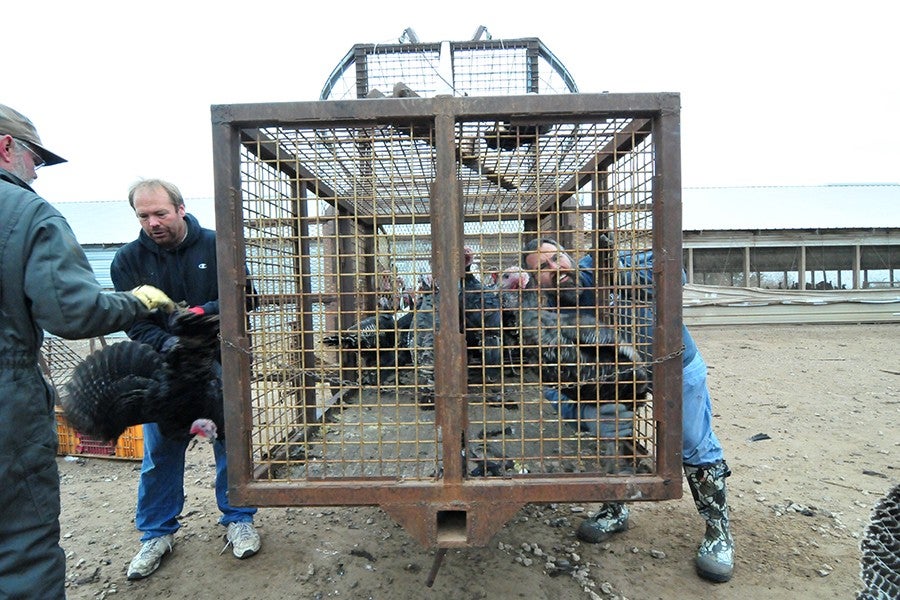
That, as much as anything else, got Frank thinking about the Poultry Institute. “We’ve got to save the birds,” he repeats.
As well as the legacies of those who preserved them once before: “I remember the people who made these birds for what they are. I remember Sadie Lloyd from Abilene, who was the great breeder of Bourbon Red turkeys. I remember Gladys Honsinger from Missouri, another great breeder of Bourbon Reds. I remember Henry Doans, probably the greatest breeder of White Holland turkeys. In fact, the father of industrial turkey breeds, George Nicholas, actually got his first turkeys from Henry Doans.”
Stepping up in the next generation, Carey, Frank’s business partner, wants to take Frank’s work (and the work of Lloyd, Honsinger, Doans and countless others) to the next level. His perspective is informed by how a changing agriculture industry impacted actual farms and farming communities. Or put another way — how communities support farms. While small towns like Lindsborg celebrate diverse interests and life-enriching pursuits, no one can deny it’s not immune to current trends. Carey points to population numbers farther west of Lindsborg on the High Plains where failed farms sit empty and are overtaken with weeds. This is where very small towns are getting smaller, and very large farms are getting larger.
That’s not a new thing, but Carey still wonders why something small and more manageable hasn’t taken hold by now. “The answer is because there’s no infrastructure anymore. There’s no place to process anything anymore. We have to find a way to make a living in agriculture — a realistic one where the buy-in isn’t millions of dollars. There is a way to make a living on a small amount of land… .”
He stops himself.
“There has to be, or else rural Kansas is done. Maybe if there were small farms people could come back to — and actually make some money while doing so — we can stop the tide of outmigration. Maybe we can reverse that decline everywhere else.”
Frank, of course, is doing everything he can to prepare for that day. The day when his birds will soar above all the others — especially the ones that are made artificially plump for deep fryers and sold as the centerpiece of fast-food value meal menus. He knows, though, that such a moment will require perfection. And so, he demands nothing less—cold-blooded as it sometimes may be. “I cull the weak,” he promises, more optimistically than ominously. “Only the strong survive.”
